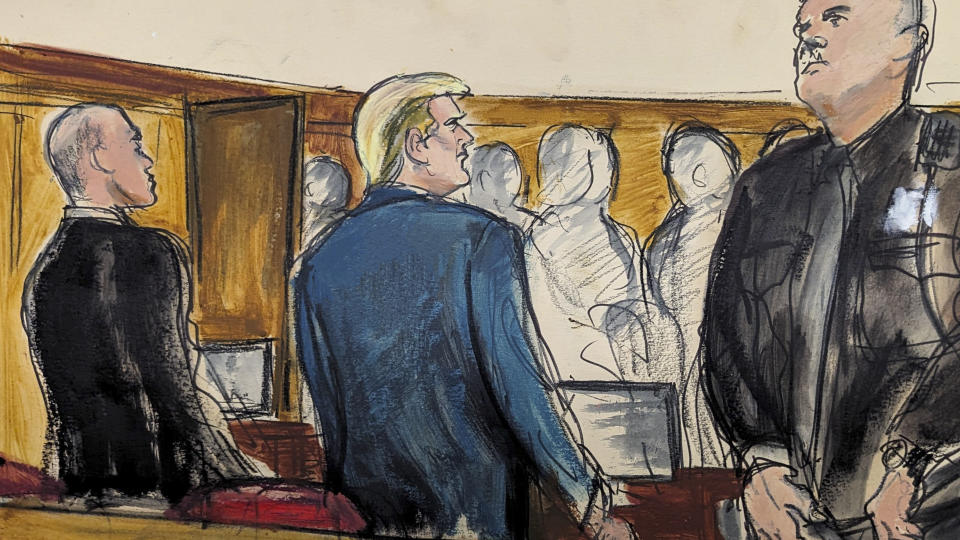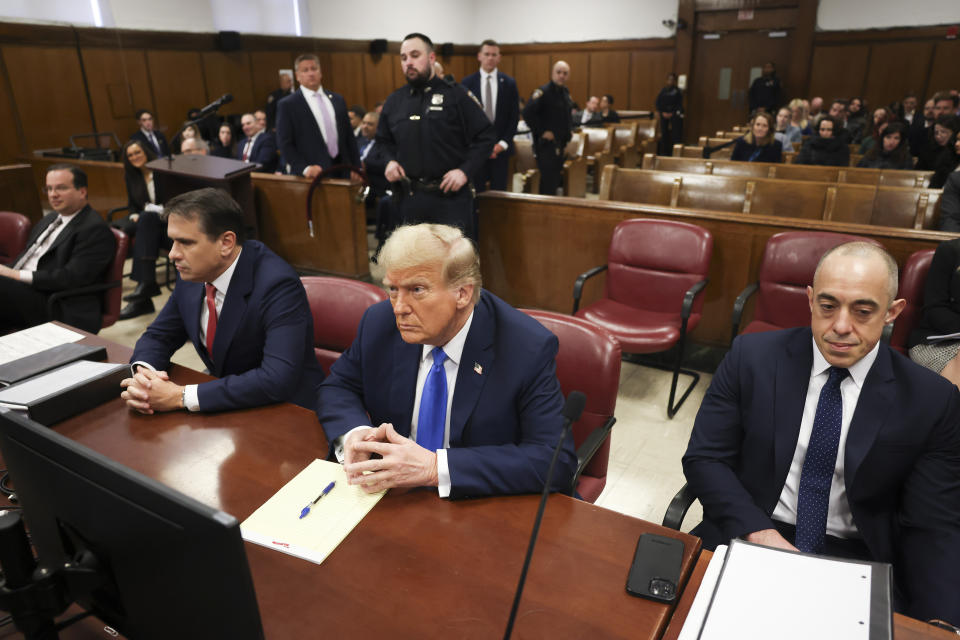Without cameras to go live, the Trump trial is proving the potency of live blogs as news tools
- Oops!Something went wrong.Please try again later.
- Oops!Something went wrong.Please try again later.
NEW YORK (AP) — They watched from the courtroom or via closed-circuit television in an overflow room — roughly 140 reporters, most with laptops or other silenced electronic devices, serving up news at its most elemental and in rapid-fire fashion.
There were utterances posted a few seconds after they left a lawyer’s mouth. Observations on how Donald Trump is reacting. Tidbits on what testimony is causing jurors to scribble notes. “Let me give you some quotes to make you feel like you’re inside the courtroom,” MSNBC’s Yasmin Vossoughian said before reading the reports of colleagues.
Trump's hush money trial is illustrating the potency of live blogs as a news tool — by necessity.
Television and text journalism are normally two very different mediums. Yet because New York state rules forbid camera coverage of trials and the former president's case has such high interest, blogs are emerging as the best way to communicate for both formats.
PRESENTING LITTLE PIECES OF THE NEWS
During opening arguments in the case on Monday, CNN used one-third of its television screen to display short printed updates of what was going on, written by its three journalists stationed at the Manhattan courthouse. MSNBC did something similar with onscreen “chyrons” — superimposed text.
Traditional outlets like The New York Times, The Washington Post and The Associated Press use news blogs regularly, experience that proved helpful Monday. While such blogs often supplement traditional television coverage of big events like the Academy Awards or election nights — it's known as a “second-screen” experience — this time consumers had no other option.
Some 140 reporters watched from the courtroom or via closed-circuit television in an overflow room, feeding news to editors. They're watched carefully themselves: Two reporters covering the trial were expelled on Monday for breaking rules prohibiting recording and photography in the overflow room, where reporters who can't get into the courtroom watch the proceedings on large screens, according to court officials.
Blog dispatches sometimes felt like bits and pieces of a print story in development, like this from The Washington Post's Devlin Barrett: “They disguised what the payments were,” (prosecutor Matthew) Colangelo said, speaking clearly and calmly with his hands in his suit pockets."
Others try to set the scene: “All 18 jurors are looking directly at the veteran prosecutor, who stands at a lectern in the middle of the courtroom about halfway between them and Trump,” wrote AP's Michael R. Sisak.
The New York Post 's Kyle Schnitzer wrote that Trump attorney Todd Blanche wrapped up his opening statement with a hometown appeal, quoting him in saying, “use your common sense, you're New Yorkers, that's why we are here.”
ANALYSIS AND DEBUNKING ARE ALSO STAPLES
Other observances are more analytical or seek to correct the record.
The Post's Shayna Jacobs wrote that “in opening statements, prosecutors focused heavily on the circumstantial evidence that they argue will help prove that Donald Trump paid off Stormy Daniels in 2016 to keep her from going public about an alleged encounter with Trump a decade before.”
The Times' Maggie Haberman wrote as Trump's attorney was delivering his opening statement that "Blanche is trying to portray the the National Enquirer's practices as similar to how other news outlets operate, in terms of deciding when and how to publish a story. That is not correct.”
For CNN and MSNBC, which covered opening arguments more extensively Monday than Trump-friendly outlets Fox News Channel and Newsmax, there were some growing pains in getting used to the new form of storytelling.
MSNBC used text less frequently, occasionally relying on the awkwardness of correspondents trying to search through notes for the latest quotes. “Trump lawyer: Trump is not on the hook for what Cohen did,” read one MSNBC chyron. “Trump lawyer: Nothing wrong with trying to influence an election,” read another.
A handful of times, CNN's Jake Tapper interrupted speakers to read blog dispatches that viewers were also able to see for themselves on their screens.
Still, the blog-like reports were often more helpful than on-screen analysts, particularly when they tried to predict what would take place next. One MSNBC pundit confidently predicted that Judge Juan Merchan would end the day's proceedings before a first witness was called and a CNN analyst said that first witness would wrap his testimony with a juicy revelation.
Neither happened.
___
David Bauder writes about media for The Associated Press. Follow him at http://twitter.com/dbauder.


